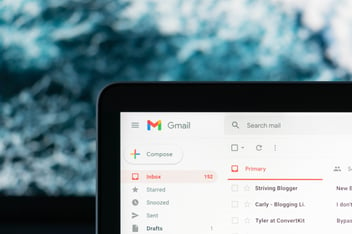The Current Abuse of Customer Data (and How You Should be Using It)
A coworker and I were having a debate about whether periods and commas should be inside or outside quotation marks, which we decided should be settled by the internet.
So I turned to one of my favorite grammar blogs (yes, they exist), but upon loading it up my Ghostery went ballistic.
For those unfamiliar with Ghostery, it’s a plugin for Chrome and Firefox that alerts you when your data is being accessed on a web page. Anytime a plugin or advertisement or analytics system grabs your cookie (and therefore your browsing history, location, IP, browser, etc), Ghostery lets you know. If you want, you can block the trackers from accessing your information.
It’s an essential tool for me as a marketer, and an easy way to stay aware as a regular Joe surfing the internet.
Anyway, Ghostery flipped out when I visited the grammar blog. 108 trackers were grabbing my information.
108! 108 companies grabbing bits and pieces of data about me. The most I’d seen previously was 75.
They got my information, and I got to learn that, in the US, commas and periods go inside the quotations.
But I’m uncertain if that was a fair exchange. I’m all for independent websites making revenue, and most of the data pulled on me is anonymous. But has this data I’m passing around made for better and more personalized experiences?
Eh, not really.
Big Data as a Substitute for Personal Experience
In a 2012 report, IDC estimated the Big Data market would reach $16.9 billion this year. And it isn’t just online - a 2014 WSJ article spoke of a startup that tracked physical movement via smartphones, helping a Chinese restaurant learn that its customers also frequented gyms and clubs.
Privacy is dying, that we can all agree on. Some people would say that it’s a fair exchange - we get free information and articles, and companies learn more about us for their marketing purposes.
The problem is, for the most part, the data isn’t being used for better experiences. It’s mostly just being used to find new ways to sell us things.
The bigger problem is the mass collection of data has led many brands away from the personal experience. You know, the information gleaned by getting up close and face-to-face with individuals.
Instead, we get broad swaths of data as a substitute. The result is impersonal experiences and the feeling of being sold at every turn.
For example, the Chinese restaurant in the WSJ article took the data about their customers being gym rats and decided to make branded exercise tanktops.
Should the data have inspired them to perhaps add lighter options to their menu, or perhaps form a partnership with the gym? Yeah, but those things could get in the way of making more sales.
(/sarcasm)
Turning Big Data into Big Delivery
Brands that continue to get personal, and invest in adding value to their customers, are the ones with the most loyal customers. Granted, there’s plenty of data involved in that, but these companies are utilizing it with the long-term in mind.
As consumers, our data is in the hands of thousands of companies. It’s sold, resold, used and often abused for random acts of marketing. Whether it actually adds value or not is often irrelevant, so long as a few more sales percolate.
There isn’t much mystery as to why 78% of the population doesn’t consider themselves loyal to any particular brand. Yet places like Starbucks, Nike, Disney, and others are building legions of diehard fans by using data to create great, personal experiences.
Think of the local cafe that knows your name and your usual order and has it ready for you. The grocery store manager that inflates a balloon for your child during your weekly shop. Businesses that are thriving are recreating that type of “we know you” experience in their marketing.
This is what we call Big Delivery. It’s when Big Data is utilized to add value to the customer experience. The result is more than just a few one-off sales; it’s a long-term customer relationship. It involves an open dialog, constant feedback loops, incentives, added value through partnerships, and many other interactions that go deeper than just “HEY YOU, BUY MORE STUFF.”
I could be wrong, maybe those 108 trackers on the grammar blog are all going to give some company a great revelation about me, and they’re going to use the data to woo my heart away with personalized experiences and value-added partnerships.
I’m not holding my breath.
In fact, the most obvious result of those 108 trackers was the a massive banner at the top of the post.
The product advertised on the banner? Spam.
Topics: customer loyalty
Written by: Brandon Carter






.jpeg)







Share your Comment.